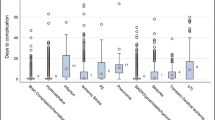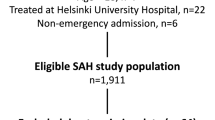Abstract
Objective
To estimate rates of all-cause and potentially preventable readmissions up to 90 days after discharge for aneurysmal subarachnoid hemorrhage (SAH) and medical comorbidities associated with readmissions
Background
Readmission rate is a common metric linked to compensation and used as a proxy to quality of care. Prior studies in SAH have reported 30-day readmission rates of 7–17% with a higher readmission risk among those with the higher SAH severity, ≥ 3 comorbidities, and non-home discharge. Intermediate-term rates, up to 90-days, and the proportion of these readmissions that are potentially preventable are unknown. Furthermore, the specific medical comorbidities associated with readmissions are unknown.
Methods
Index SAH admissions were identified from the 2013 Nationwide Readmissions Database. All-cause readmissions were defined as any readmission during the 30-, 60-, and 90-day post-discharge period. Potentially preventable readmissions were identified using Prevention Quality Indicators developed by the US Agency for Healthcare Research and Quality. Unadjusted and adjusted Poisson models were used to identify factors associated with increased readmission rates.
Results
Out of 9987 index admissions for SAH, 7949 (79%) survived to discharge. The percentage of 30-, 60-, and 90-day all-cause readmissions were 7.8, 16.6, and 26%, respectively. Up to 14% of readmissions in the first 30 days were considered potentially preventable and acute conditions (dehydration, bacterial pneumonia, and urinary tract infections) accounted for over half, whereas acute cerebrovascular disease was the most common cause for neurological return. In multivariable analysis, significant predictors of a higher readmission rate included diabetes (rate ratio [RR] 1.09, 95% confidence interval [CI] 1.03–1.15), congestive heart failure (RR 1.09, 1.003–1.18), and renal impairment (RR 1.35, 1.13–1.61). Only discharge home was associated with a lower readmission rate (RR 0.89, 0.85–0.93).
Conclusions
SAH has a 30-day readmission rate of 7.8% which continues to rise into the intermediate-term. A low but constant proportion of readmissions are potentially preventable. Several chronic medical comorbidities were associated with readmissions. Prospective studies are warranted to clarify causal relationships.
Similar content being viewed by others
References
US Centers for Medicare & Medicaid Services. Hospital readmissions reductions program (HRRP). https://www.cms.gov/Medicare/Medicare-Fee-for-Service-Payment/AcuteInpatientPPS/Readmissions-Reduction-Program.html. Accessed 21 July 2017.
Rincon F, Rossenwasser RH, Dumont A. The epidemiology of admissions of nontraumatic subarachnoid hemorrhage in the United States. Neurosurgery. 2013;73:217–22 discussion 2–3.
Go AS, Mozaffarian D, Roger VL, et al. Heart disease and stroke statistics–2013 update: a report from the American Heart Association. Circulation. 2013;127:e6–245.
Johnston SC, Selvin S, Gress DR. The burden, trends, and demographics of mortality from subarachnoid hemorrhage. Neurology. 1998;50:1413–8.
Kreiter KT, Rosengart AJ, Claassen J, et al. Depressed mood and quality of life after subarachnoid hemorrhage. J Neurol Sci. 2013;335:64–71.
Ridwan S, Urbach H, Greschus S, von Hagen J, Esche J, Bostrom A. Health care costs of spontaneous aneurysmal subarachnoid hemorrhage for rehabilitation, home care, and in-hospital treatment for the first year. World Neurosurg. 2017;97:495–500.
Mozaffarian D, Benjamin EJ, Go AS, et al. Heart disease and stroke statistics—2015 update: a report from the American Heart Association. Circulation. 2015;131:e29–322.
Linn FH, Rinkel GJ, Algra A, van Gijn J. Incidence of subarachnoid hemorrhage: role of region, year, and rate of computed tomography: a meta-analysis. Stroke J Cereb Circ. 1996;27:625–9.
Broderick JP, Brott T, Tomsick T, Huster G, Miller R. The risk of subarachnoid and intracerebral hemorrhages in blacks as compared with whites. N Engl J Med. 1992;326:733–6.
Singh M, Guth JC, Liotta E, et al. Predictors of 30-day readmission after subarachnoid hemorrhage. Neurocrit Care. 2013;19:306–10.
Greenberg JK, Guniganti R, Arias EJ, et al. Predictors of 30-day readmission after aneurysmal subarachnoid hemorrhage: a case-control study. J Neurosurg. 2017;126:1847–54.
Greenberg JK, Washington CW, Guniganti R, Dacey RG Jr, Derdeyn CP, Zipfel GJ. Causes of 30-day readmission after aneurysmal subarachnoid hemorrhage. J Neurosurg. 2016;124:743–9.
Lichtman JH, Jones SB, Leifheit-Limson EC, Wang Y, Goldstein LB. 30-day mortality and readmission after hemorrhagic stroke among Medicare beneficiaries in Joint Commission primary stroke center-certified and noncertified hospitals. Stroke; a journal of cerebral circulation. 2011;42:3387–91.
Dasenbrock HH, Angriman F, Smith TR, et al. readmission after aneurysmal subarachnoid hemorrhage: A nationwide readmission database analysis. Stroke J Cereb Circ. 2017;48:2383–90.
Lichtman JH, Leifheit-Limson EC, Jones SB, Wang Y, Goldstein LB. Preventable readmissions within 30 days of ischemic stroke among medicare beneficiaries. Stroke J Cereb Circ. 2013;44:3429–35.
Prescott HC, Langa KM, Iwashyna TJ. Readmission diagnoses after hospitalization for severe sepsis and other acute medical conditions. JAMA. 2015;313:1055–7.
Agency for Healthcare Research and Quality. Prevention quality indicators resources. https://www.qualityindicators.ahrq.gov/modules/pqi_resources.aspx. Accessed 20 July 2017.
Washington CW, Derdeyn CP, Dacey RG Jr, Dhar R, Zipfel GJ. Analysis of subarachnoid hemorrhage using the nationwide inpatient sample: the NIS-SAH severity score and outcome measure. J Neurosurg. 2014;121:482–9.
Claassen J, Bateman BT, Willey JZ, et al. Generalized convulsive status epilepticus after nontraumatic subarachnoid hemorrhage: the nationwide inpatient sample. Neurosurgery. 2007;61:60–4 discussion 4–5.
Bateman BT, Olbrecht VA, Berman MF, Minehart RD, Schwamm LH, Leffert LR. Peripartum subarachnoid hemorrhage: nationwide data and institutional experience. Anesthesiology. 2012;116:324–33.
Tirschwell DL, Longstreth WT. Validating administrative data in stroke research. Stroke J Cereb Circ. 2002;33:2465–70.
Kokotailo RA, Hill MD. Coding of stroke and stroke risk factors using international classification of diseases, revisions 9 and 10. Stroke J Cereb Circ. 2005;36:1776–81.
Feigin VL, Rinkel GJE, Lawes CMM, et al. Risk factors for subarachnoid hemorrhage. An updated systematic review of epidemiological studies. Stroke. 2005;36:2773–80.
Connolly ES, Rabinstein AA, Carhuapoma JR, et al. Guidelines for the management of aneurysmal subarachnoid hemorrhage. A guideline for healthcare professionals from the American Heart Association/American Stroke Association 2012.
Lindbohm JV, Kaprio J, Jousilahti P, Salomaa V, Korja M. Risk factors of sudden death from subarachnoid hemorrhage. Stroke. 2017;48(9):2399–404.
Yao XY, Jiang CQ, Jia GL, Chen G. Diabetes mellitus and the risk of aneurysmal subarachnoid haemorrhage: A systematic review and meta-analysis of current evidence. J Int Med Res. 2016;44:1141–55.
Vahidy FS, Donnelly JP, McCullough LD, et al. Nationwide estimates of 30-day readmission in patients with ischemic stroke. Stroke J Cereb Circ. 2017;48:1386–8.
Acknowledgements
This work was supported in part through the computational resources and staff expertise provided by Scientific Computing at the Icahn School of Medicine at Mount Sinai.
Funding
None.
Author information
Authors and Affiliations
Contributions
JWL and SOS were involved in study concept and design. JWL and LC drafted the manuscript. JWL, LC, LVO and MD helped in acquisition, analysis, or interpretation of data. MD performed statistical analysis. SOS and MD contributed to critical revision of the manuscript.
Corresponding author
Ethics declarations
Conflict of interest
The authors declare that they have no conflict of interest.
Ethical Approval
All procedures performed in studies involving human participants were in accordance with the ethical standards of the institutional research committee and with the 1964 Helsinki declaration and its later amendments or comparable ethical standards.
Electronic supplementary material
Below is the link to the electronic supplementary material.
Rights and permissions
About this article
Cite this article
Liang, J.W., Cifrese, L., Ostojic, L.V. et al. Preventable Readmissions and Predictors of Readmission After Subarachnoid Hemorrhage. Neurocrit Care 29, 336–343 (2018). https://doi.org/10.1007/s12028-018-0557-1
Published:
Issue Date:
DOI: https://doi.org/10.1007/s12028-018-0557-1




